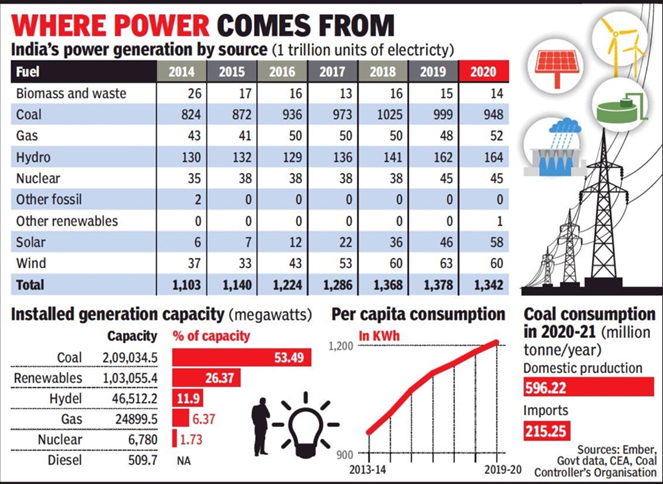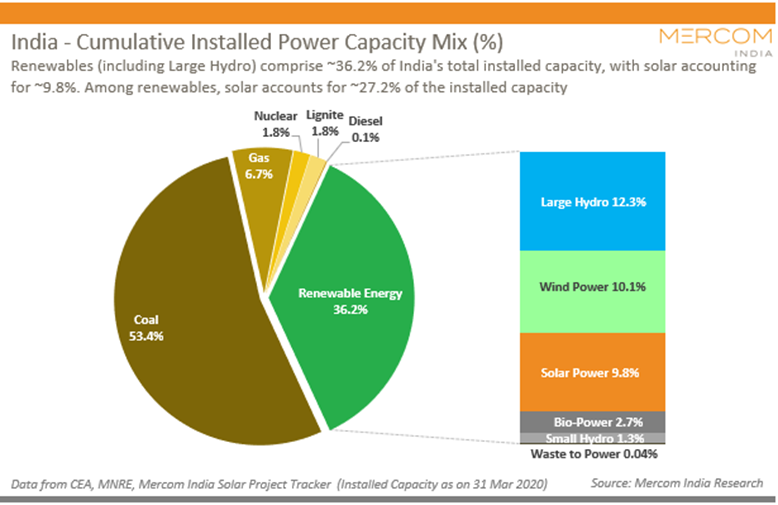In News:
- China led global coal power expansion in 2021, with about 25,000 MW of new plants, followed by India with about 6,100 MW
- However, Global coal-plant capacity under development declined in 2021, according to a report by the Global Energy Monitor.
- After rising in 2020 for the first time since 2015, total coal power capacity under development declined 13% last year, from 525 gigawatts (GW) to 457 GW.
What’s in today’s article:
- Coal distribution across the world (75% reserves are controlled by 5 countries)
- India’s coal reserves (India’s dependency on coal, does India need new coal plants, etc.)
- News Summary (Major findings of the report by Global Energy Monitor)
Distribution of Coal across the world:
- Coal is a widespread resource for energy and chemicals.
- The quantities of proven coal reserves in the world are typically shown in Millions of Tons of Coal Equivalent (MTCE).
- Nearly 75% of the world’s recoverable coal resources are controlled by five countries:

India’s Coal Reserves:
- India holds fifth-largest coal reserves in the world.
- Commercial coal-mining industry has been in operation since 1774, launched by the East India Company along the Damodar River in West Bengal.
- 70% of India’s coal supply comes from the states of Jharkhand, Chhattisgarh, Odisha, West Bengal and Madhya Pradesh.
- State-owned Coal India Limited has a virtual monopoly on coal mines in India, which produce roughly 75% of the coal burned in India’s coal-fired power stations.
India’s Dependence on Coal for Energy Supply:


- Coal is expected to account for at least 21% of India’s electricity requirements even by 2050.
- Easily available source of power:
- Coal can help the country meet its energy needs without depending on imports as it is abundantly available domestically.
- Alternatives like nuclear energy have been hampered by high costs and safety concerns.
- India’s Developmental needs:
- To lift millions of people out of poverty, India needs energy.
- The International Energy Agency (IEA) predicts that between 2020 and 2040, India will have the largest growth in energy demand of any country in the world.
- To meet this demand, India will need to rely on a variety of energy sources—both conventional and renewable.
- Source of Employment:
- Coal is also a vital source of jobs and economic growth and a driver of industrialization, just as it was in developed countries.
- Around 4 million people in India are employed either directly or indirectly in the coal sector. Other than active workers, another 500,000 Indians rely on the coal sector for their pensions.
- Source of Revenue for the Government:
- Coal India Limited is the largest coal mining company in the world.
- The coal sector is a major source of revenue for States and the Central Government.
Does India Need New Coal Plants?
- According to a report prepared by EMBER in September 2021, an independent British energy think-tank, in collaboration with Bangalore-based Climate Risk Horizons, India does not require additional new coal capacity to meet expected demand growth by financial year 2030.
- India’s peak demand would reach 301 GW by 2030, if it grows at an annual growth rate of 5%, which is also in lines with projections made by the Central Electricity Authority. India’s planned solar capacity can cover much of it.
- In other words, more coal capacity beyond what’s already under construction isn’t needed to meet the aggregate demand growth by FY 2030.
- The report also finds that India can free up Rs. 2,47,421 crore by “killing” the zombie coal projects
- Once incurred, these wasted investments will lock DISCOMs (power distribution companies) and consumers into expensive contracts and jeopardise India’s Renewable Energy goals by adding to the system’s overcapacity.
News Summary:
- Global coal-plant capacity under development declined in 2021, according to a report by the Global Energy Monitor.
- Global Energy Monitor conducts an annual survey of coal power capacity under development or deployment.
Major Findings of the Report:
- 34 countries have new coal plants under consideration, down from 41 countries in January 2021.
- China, South Korea, and Japan have pledged to stop funding new coal plants in other countries, but China continued to lead all countries in domestic development of new coal plants, commissioning more coal capacity than the rest of the world combined.
- In all, 45,000 MW of global coal power capacity — a little over half of which was from China — was commissioned in 2021 while 26,8000 MW was retired, causing a net increase in the global coal fleet of 18,200 MW.
- 2021 was a significant year in the continued global shift away from new coal power, as 65 countries made commitments not to build new plants.
- There has been a 77% fall in coal plant capacity in pre-construction since the Paris Agreement was signed in 2015.










